- Physostegia: an overview
- Characteristics
- Cultivation
- Species and Varieties
- Growing Physostegia from seeds
- Choosing the seeds
- Sowing the seeds
- Care after sowing
- Transplanting the seedlings
- Caring for Physostegia plants
- Species of Physostegia
- 1. Physostegia virginiana
- 2. Physostegia angustifolia
- 3. Physostegia correllii
- 4. Physostegia digitalis
- 5. Physostegia parviflora
- Varieties of Physostegia
- 1. Physostegia virginiana ‘Pink Manners’
- 2. Physostegia virginiana ‘Vivid’
- 3. Physostegia virginiana ‘Miss Manners’
- 4. Physostegia virginiana ‘Rosea’
- 5. Physostegia virginiana ‘Alba’
- Care and maintenance of Physostegia
- Watering
- Light and temperature
- Soil
- Fertilizer
- Pruning
- Pest and disease control
- Propagation
- Winter care
- Uses of Physostegia
- 1. Garden Decoration
- 2. Attracting Pollinators
- 3. Cut Flowers
- 4. Naturalizing Landscapes
- 5. Medicinal Uses
- Troubleshooting common issues with Physostegia
- Poor growth or wilting leaves
- Pest infestation
- Disease problems
- Flowering issues
- Questions and Answers:
- How do I grow physostegia from seeds?
- What are some species of physostegia?
- How tall do physostegia plants grow?
- What are some popular varieties of physostegia?
- When should I plant physostegia seeds?
- Do physostegia plants attract pollinators?
- Videos: Planting 5 Varieties of Echinacea! // Garden Answer
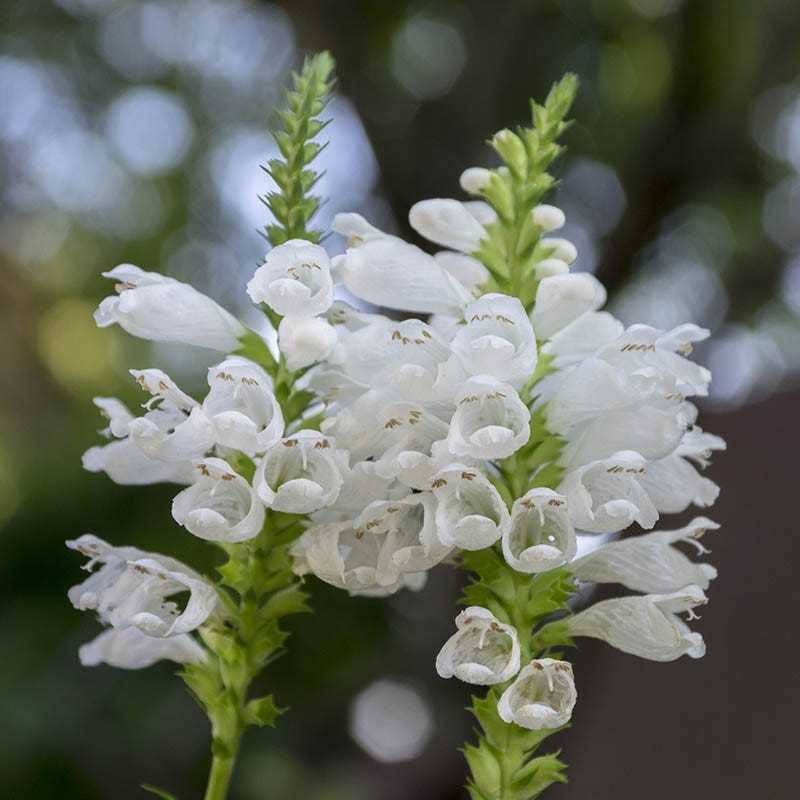
Welcome to our comprehensive guide on Physostegia, a beautiful flowering plant that is known for its vibrant colors and unique structure. Whether you are an experienced gardener or just starting out, this article will provide you with all the essential information you need to grow Physostegia from seeds, learn about different species and varieties, and understand how to care for them.
Physostegia, also known as Obedient Plant or False Dragonhead, is a native plant to North America. It is a member of the mint family, Lamiaceae, and is renowned for its attractive spikes of flowers that bloom from mid-summer to fall. The name “Obedient Plant” comes from its ability to retain the position in which its flowers are moved, giving it a unique and interesting characteristic.
If you are interested in growing Physostegia from seeds, we will guide you through the whole process. We’ll explore the ideal conditions for planting, germination techniques, and the best time to sow the seeds. Additionally, we will provide tips on how to care for the seedlings and transplant them into your garden.
There are several species and varieties of Physostegia, each with its own distinctive features. We’ll introduce you to some of the most popular ones, including Physostegia virginiana, Physostegia intermedia, and Physostegia angustifolia. You’ll learn about their unique characteristics, growing requirements, and how they can be utilized in different garden settings.
Whether you are a fan of vibrant pinks, soft lavenders, or intense purples, Physostegia has a variety to suit every taste. From the classic ‘Miss Manners’ with its tightly packed pink flowers, to the stunning ‘Summer Snow’ with its white blooms, we will explore the different varieties and help you select the perfect Physostegia for your garden.
So sit back, relax, and get ready to discover everything you need to know about growing Physostegia from seeds, the various species and varieties available, and how you can use this beautiful plant to create an eye-catching focal point in your garden.
Physostegia: an overview
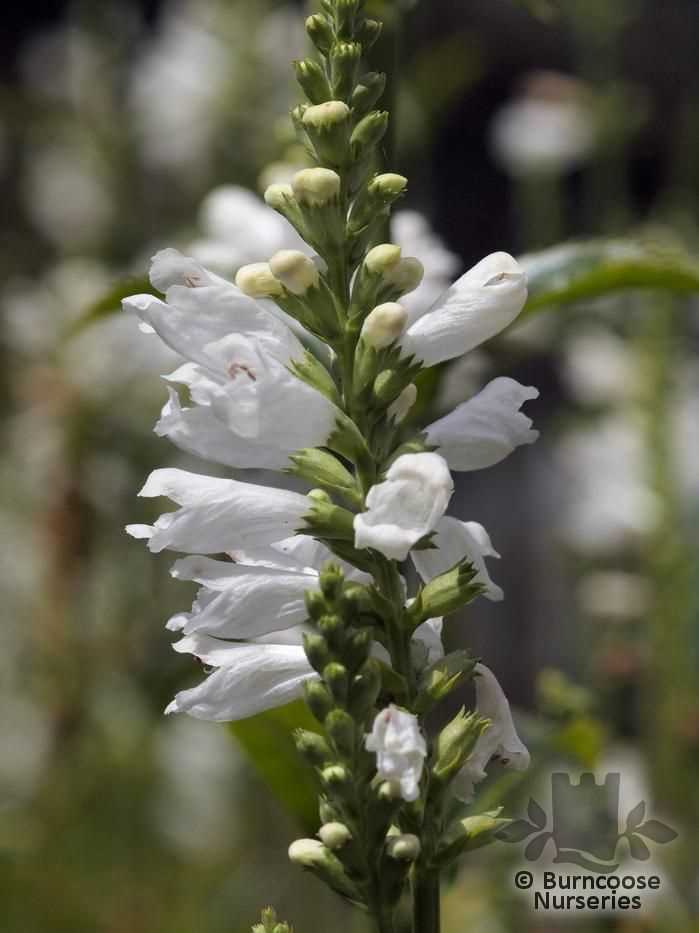

Physostegia, commonly known as obedient plant or false dragonhead, is a genus of flowering plants in the mint family, Lamiaceae. Native to the wetlands of North America, Physostegia species are known for their beautiful and showy flowers, as well as their ability to attract pollinators like bees and butterflies. With their unique characteristics and easy cultivation, Physostegia has become a popular choice among gardeners and plant enthusiasts.
Characteristics
Physostegia plants typically grow upright and can reach heights of 2 to 4 feet. The stems are square-shaped, a common feature of plants in the mint family. The leaves are lance-shaped and have a toothed edge. One of the notable characteristics of Physostegia is its ability to stay in whatever position it is moved to, hence the common name “obedient plant.” The flowers are tubular and arranged in whorls around the stem. They come in a variety of colors, including shades of pink, purple, and white.
Cultivation
Physostegia can be grown from seeds or propagated through division. The seeds should be sown in a well-drained soil mix and kept moist until germination, which typically takes about 2 to 4 weeks. Once the seedlings have developed a few sets of true leaves, they can be transplanted into individual pots or directly into the garden.
Physostegia prefers full sun to partial shade and moist, fertile soil. Regular watering is essential to keep the plants healthy, especially during dry spells. Mulching around the base of the plants can help retain moisture in the soil. Physostegia also benefits from deadheading, which involves removing faded flowers to encourage continuous blooming throughout the season.
Species and Varieties
There are several species of Physostegia, each with its own unique characteristics. The most common species include Physostegia virginiana, Physostegia intermedia, and Physostegia digitalis. Varieties within these species can vary in terms of flower color, height, and overall growth habit. Some popular varieties include ‘Vivid’, ‘Pink Manners’, and ‘Crystal Peak White’.
| Species | Varieties |
|---|---|
| Physostegia virginiana | ‘Miss Manners’, ‘Summer Snow’, ‘Variegata’ |
| Physostegia intermedia | ‘Bouquet Rose’, ‘Pink Bouquet’, ‘Rosea’ |
| Physostegia digitalis | ‘Crème Brulee’, ‘Summer Breeze’, ‘Starling’ |
Overall, Physostegia is a stunning flowering plant that adds beauty and charm to any garden or landscape. With its range of colors and easy cultivation, it is no wonder why this plant has become a favorite among many gardeners.
Growing Physostegia from seeds
Growing Physostegia from seeds is a great way to add these beautiful plants to your garden. Here is everything you need to know to successfully grow Physostegia from seeds:
Choosing the seeds
When choosing Physostegia seeds, look for varieties that are known to be successful in your climate zone. This will increase the chances of your seeds germinating and growing into healthy plants.
Sowing the seeds
Physostegia seeds are usually sown directly into the garden soil in spring or fall, depending on your climate. Prepare the soil by removing any weeds and loosening it with a garden fork or tiller.
Make small holes in the soil, about 1/4 inch deep, and place a few seeds in each hole. Cover the seeds with soil and gently pat it down to ensure good soil-to-seed contact.
Care after sowing
After sowing the seeds, keep the soil consistently moist until germination occurs. This can take anywhere from 1 to 4 weeks. Water the soil regularly, but be careful not to overwater, as this can cause the seeds to rot.
Once the seedlings emerge, thin them out to a spacing of 10-12 inches apart to ensure adequate air circulation and prevent overcrowding.
Transplanting the seedlings
If you started your seeds indoors, you may need to transplant the seedlings to larger pots before planting them in the garden. This will give them more space to grow and develop a strong root system.
When transplanting, be sure to handle the seedlings gently and disturb the roots as little as possible. Plant them at the same depth they were growing in the original container and water the soil thoroughly after transplanting.
Caring for Physostegia plants
Physostegia plants prefer moist, well-draining soil and full sun to partial shade. Water them regularly, especially during dry periods, and mulch around the base of the plants to help retain moisture and suppress weeds.
Deadhead the flowers after they fade to encourage more blooms and remove any diseased or damaged foliage to prevent the spread of pests and diseases.
By following these steps, you can successfully grow Physostegia from seeds and enjoy their beautiful flowers in your garden.
Species of Physostegia
Physostegia is a genus of flowering plants in the mint family, Lamiaceae. There are several species of Physostegia, each with its own unique characteristics and growth habits.
1. Physostegia virginiana
Also known as the obedient plant or false dragonhead, Physostegia virginiana is the most common species found in gardens. It is native to North America and is known for its ability to stay in a fixed position when bent. The flowers of Physostegia virginiana range from pink to white and bloom from late summer to early fall.
2. Physostegia angustifolia
Physostegia angustifolia is also known as narrowleaf false dragonhead. It is native to the southeastern United States and is characterized by its narrow leaves and pink to purple flowers. This species blooms from late spring to early summer and is a popular addition to wildflower gardens.
3. Physostegia correllii
Physostegia correllii is a rare species that is native to Texas. It has purplish-pink flowers and is known for its long, slender leaves. This species prefers rocky, limestone soils and is often found in prairies and open woodlands.
4. Physostegia digitalis
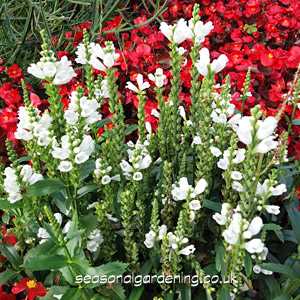

Physostegia digitalis, commonly known as the false dragonhead or digitalis beardtongue, is native to eastern and central North America. It has white to pale pink flowers and is often found in wet habitats such as marshes, swamps, and stream banks. This species blooms from late spring to early summer.
5. Physostegia parviflora
Physostegia parviflora, also known as smallflower false dragonhead, is found in southeastern and central United States. It has pink to purple flowers and prefers moist, shaded areas. This species blooms from late spring to early summer.
These are just a few examples of the species of Physostegia. Each species has its own unique beauty and characteristics, making them a popular choice for gardeners and plant enthusiasts alike.
Varieties of Physostegia
Physostegia is a versatile plant that comes in several different varieties. Each variety has its own unique characteristics, making it easy for gardeners to find the perfect Physostegia to suit their needs and preferences. Here are some of the most popular varieties of Physostegia:
1. Physostegia virginiana ‘Pink Manners’
This variety features stunning spikes of bright pink flowers, which bloom from summer to fall. ‘Pink Manners’ is known for its ability to attract butterflies and hummingbirds to the garden. It grows to a height of 2-3 feet and prefers full sun to partial shade.
2. Physostegia virginiana ‘Vivid’
‘Vivid’ is another popular variety of Physostegia that produces vibrant magenta flowers. It has a compact growth habit, reaching a height of about 2 feet. This variety is a great choice for borders or containers and thrives in full sun.
3. Physostegia virginiana ‘Miss Manners’
‘Miss Manners’ is a dwarf variety of Physostegia that grows to a height of only 8-12 inches. It features delicate spikes of pink flowers and is well-suited for small gardens or planting as a groundcover. ‘Miss Manners’ prefers full sun but can tolerate some shade.
4. Physostegia virginiana ‘Rosea’
This variety of Physostegia has soft pink flowers that bloom from summer to fall. It grows to a height of about 3 feet and prefers full sun to partial shade. ‘Rosea’ is a versatile choice for borders, beds, or cut flower arrangements.
5. Physostegia virginiana ‘Alba’
‘Alba’ is a variety of Physostegia that features pure white flowers. It has a compact growth habit, reaching a height of 1-2 feet. ‘Alba’ is a great choice for adding contrast and brightness to the garden, and it thrives in full sun.
These are just a few examples of the many varieties of Physostegia available to gardeners. Each variety brings its own unique beauty to the garden, making it a favorite among those who appreciate its versatility and charm.
Care and maintenance of Physostegia
Watering
Physostegia plants require regular watering to keep the soil consistently moist, especially during hot and dry periods. However, they cannot tolerate waterlogged conditions, so it is important to provide well-draining soil. Water deeply, allowing the water to reach the roots, and avoid wetting the leaves as it can promote the growth of fungal diseases.
Light and temperature
Physostegia plants thrive in full sun to partial shade. They prefer a minimum of 6 hours of direct sunlight per day. In terms of temperature, these plants are adaptable and can tolerate a range of climates. However, they generally prefer moderate temperatures between 60°F (15°C) and 75°F (24°C).
Soil
Physostegia plants prefer well-draining soil that is rich in organic matter. They can tolerate a variety of soil types, including clay, loam, and sandy soil. It is recommended to amend the soil with compost or peat moss to improve its fertility and drainage.
Fertilizer
Physostegia plants benefit from regular fertilization to promote healthy growth and abundant flowering. Use a balanced, slow-release fertilizer in early spring or a liquid fertilizer every 4-6 weeks during the growing season. Be cautious not to over-fertilize, as it can lead to excessive foliage growth at the expense of flowers.
Pruning
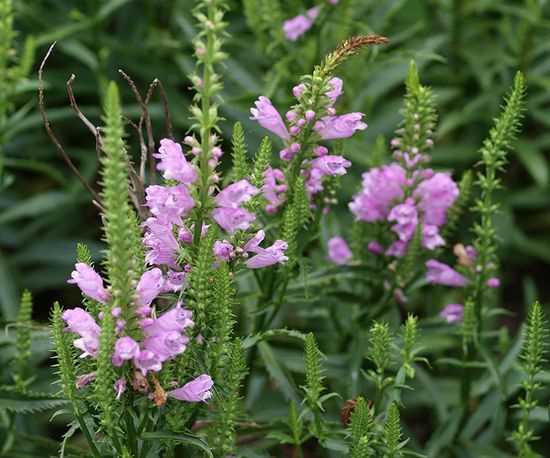

Physostegia plants do not require extensive pruning. However, you can trim the stems after flowering to remove dead flowers and promote a neat appearance. Additionally, cutting back the plant in late fall or early spring can help control its spread and maintain its compact shape.
Pest and disease control
Physostegia plants are generally resistant to pests and diseases. However, they can occasionally suffer from aphid infestations or fungal diseases, such as powdery mildew. Regularly inspect the plants for any signs of pests or diseases and take appropriate measures, such as using insecticidal soap or fungicides, if needed.
Propagation
Physostegia plants can be propagated through division or by sowing seeds. To propagate through division, dig up the plant in early spring and carefully separate the root clumps. Replant the divided sections in well-prepared soil. To propagate from seeds, sow them indoors in early spring or outdoors after the danger of frost has passed. Keep the soil consistently moist and provide the seedlings with adequate light until they are ready to be transplanted outdoors.
Winter care
Physostegia plants are generally hardy and can withstand cold winters. However, in areas with harsh winters, it is recommended to provide a layer of mulch around the plants in late fall to protect the roots from freezing. In spring, remove the mulch once the danger of frost has passed.
Uses of Physostegia
Physostegia plants, also known as obedient plants, have a variety of uses in different settings. Here are some of the common uses of physostegia:
1. Garden Decoration
- Physostegia plants are popular choices for garden decoration due to their attractive blooms and upright growth habit.
- They can be planted in borders, mixed flower beds, or grown in containers to add color and texture to the garden.
2. Attracting Pollinators
- The flowers of physostegia plants are rich in nectar and attract a variety of pollinators such as bees, butterflies, and hummingbirds.
- Planting physostegia in your garden can help attract and support these important pollinators.
3. Cut Flowers
- The tall spikes of physostegia flowers make them a popular choice for cut flower arrangements.
- They can be used in fresh bouquets or dried flower arrangements, adding a touch of elegance to any floral display.
4. Naturalizing Landscapes
- Some species of physostegia have the ability to naturalize and spread in landscapes, making them suitable for meadows, prairies, or wildflower gardens.
- They can help create a naturalistic look and provide habitat for native wildlife.
5. Medicinal Uses
- In traditional medicine, physostegia plants have been used to treat various ailments such as digestive issues, fevers, and respiratory conditions.
- However, it’s important to consult a healthcare professional before using physostegia for medicinal purposes.
With their beautiful flowers, ability to attract pollinators, and versatility in different settings, physostegia plants offer both aesthetic and functional value to any garden or landscape.
Troubleshooting common issues with Physostegia
Physostegia plants are generally resilient and easy to grow, but like any other plant, they can face some common issues. Here are some troubleshooting tips to help you identify and resolve these issues:
Poor growth or wilting leaves
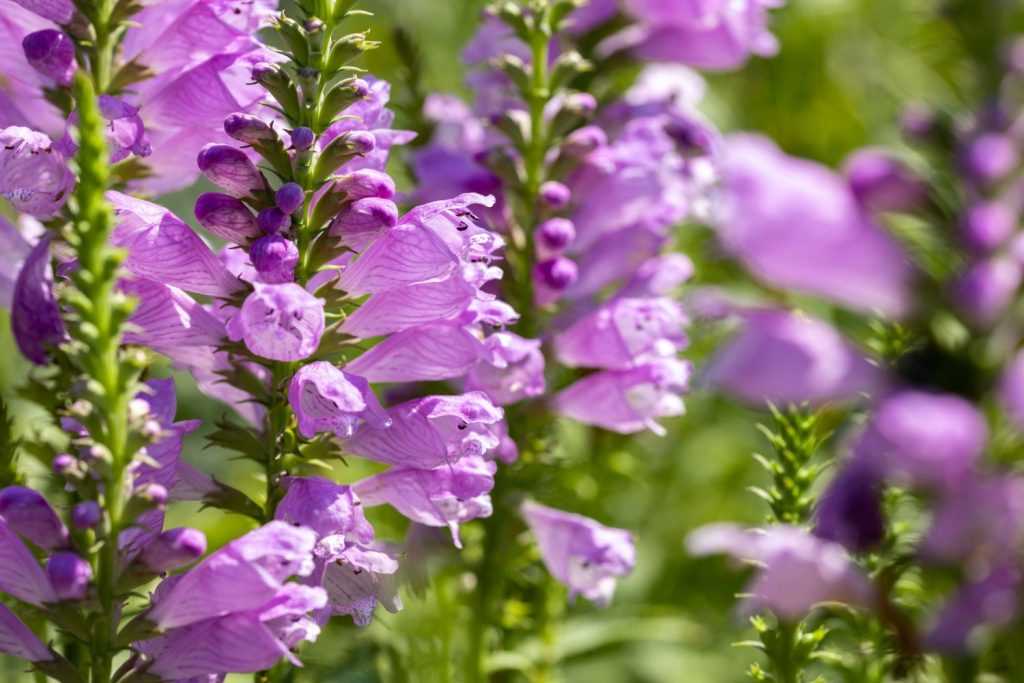

- Ensure that your Physostegia plants are getting enough sunlight. They thrive in full sun conditions but can tolerate some shade.
- Check the soil moisture levels regularly. Physostegia plants prefer moist soil, so make sure you are not overwatering or underwatering them.
- Inspect the roots for any signs of rot or damage. If you find any issues, gently remove the affected roots and replant the Physostegia plant.
- Consider using a slow-release fertilizer to provide essential nutrients to the plants.
Pest infestation
- Check the leaves and stems of your Physostegia plants for any signs of pests such as aphids, spider mites, or slugs.
- If you spot pests on your plants, try using organic pest control methods such as neem oil spray or insecticidal soap.
- Remove any infested leaves or stems to prevent the pests from spreading.
Disease problems
- Avoid overwatering your Physostegia plants, as excess moisture can lead to root rot and fungal diseases. Ensure that the soil is well-draining.
- If you notice any signs of disease such as leaf spots or powdery mildew, prune the affected parts and apply a fungicide according to the instructions.
- Rotate your Physostegia plants with other non-related plants each year to prevent the buildup of soil-borne diseases.
Flowering issues
- If your Physostegia plants are not flowering, it could be due to insufficient sunlight. Ensure that they are receiving at least 6-8 hours of direct sunlight each day.
- Check if the plants are overcrowded. Physostegia plants perform best when they have enough space to grow and spread.
- Remove any competing weeds or plants around your Physostegia plants, as they can hinder their growth and flowering.
By following these troubleshooting tips, you can ensure that your Physostegia plants thrive and produce beautiful blooms. Remember to regularly monitor and maintain the growing conditions to keep your plants healthy.
Questions and Answers:
How do I grow physostegia from seeds?
To grow physostegia from seeds, you need to start them indoors in early spring. Sow the seeds in trays filled with a well-draining potting mix, and lightly press them into the soil. Keep the trays in a warm location and ensure the soil remains moist. Once the seedlings have grown a few inches tall, you can transplant them into larger pots or directly into the garden.
What are some species of physostegia?
Physostegia, also known as obedient plant, belongs to the mint family. Some common species of physostegia include Physostegia virginiana, Physostegia parviflora, and Physostegia intermedia. These species vary in their growth habits, flower colors, and hardiness.
How tall do physostegia plants grow?
The height of physostegia plants can vary depending on the species and variety. On average, they can grow anywhere from 2 to 4 feet tall. Some taller varieties can reach heights of up to 6 feet. It’s important to consider the specific cultivar when planting physostegia to ensure it fits well in your garden or landscape.
What are some popular varieties of physostegia?
There are several popular varieties of physostegia that gardeners often choose based on their preferences. Some examples include ‘Miss Manners’ with pale pink flowers, ‘Summer Snow’ with white flowers, ‘Vivid’ with vibrant pink flowers, and ‘Firebird’ with deep magenta flowers. These varieties offer a range of colors and growth habits that can suit different garden styles.
When should I plant physostegia seeds?
You should plant physostegia seeds indoors in early spring, around 6-8 weeks before the last expected frost date in your area. This allows the seeds enough time to germinate and the seedlings to grow before being transplanted outdoors. Physostegia plants can also be directly sown into the garden in the spring once the soil has warmed up.
Do physostegia plants attract pollinators?
Yes, physostegia plants are known to attract pollinators such as bees, butterflies, and hummingbirds. The tubular-shaped flowers of physostegia have a rich nectar source that these pollinators find irresistible. Planting physostegia in your garden can help create a pollinator-friendly environment and support the local ecosystem.







